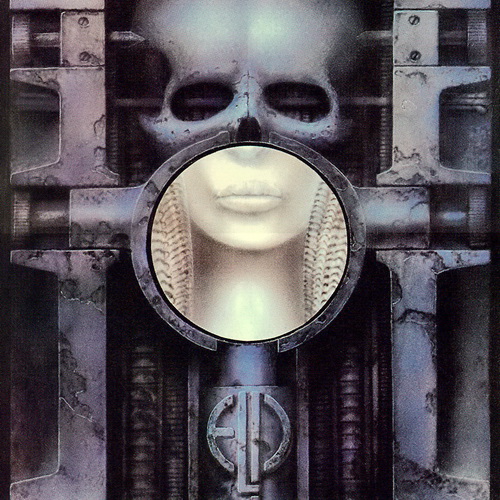Born Hans Rudolf Giger (pronounced GEE-gur) in February of 1940, H.R. Giger’s influence was felt throughout every aspect of the art world. With his recent passing, Giger’s legacy is strong in the minds of all who have been affected by it – from the baby boomers first exposed to his work on album covers, to the Horror/Sci-Fi movie fans in love with his creatures, to the slightly-off teenager with posters of his bio-erotic artwork on his walls.
Initially encouraged by his father to pursue a career in pharmaceuticals, the Swiss native thankfully rejected that idea to study architecture and industrial design, two subjects that greatly influenced his work later. Giger combined images of man and machine to create terrifying landscapes, often devoid of color. His work was not for the conservative mind or faint-of-heart; his fantasies on canvas and in sculptures usually contained graphic sexual imagery and had very clear Satanic overtones.
Giger worked to distribute his art, not only on canvasses and in galleries, but also in the commercial world. He released books, directed films, and licensed his works out to other artists. His influence has touched the worlds of music, film, and even interior design. Hard-core gamers with really good memories may recall Dark Seed, the 1992 computer game created with Giger’s guidance.
His album covers, both commissioned and reproduced works, are synonymous with the acts that have used them. Emerson, Lake, & Palmer, Debbie Harry, Celtic Frost, Carcass, Atrocity, and Danzig have all used Giger art on covers that have helped to make the albums they adorn classics. Jello Biafra used Giger’s Penis Landscape painting as the insert for the Dead Kennedys’ third album, 1985’s Frankenchrist. The ensuing controversy nearly bankrupted Alternative Records, Jello’s record label. Giger also famously designed a one-of-a-kind mic stand for Korn frontman Jonathan Davis, lovingly reproduced by McFarlane Toys as an accessory for the Davis action figure released in 2000. Ibanez also has an H.R. Giger signature series of guitars.
Alexander Krull of Atrocity states, “We are still filled with gratitude for all his creativity and help concerning the cover artwork of the Atrocity Hallucinations (1990) album. I remember the days when we got in contact for the first time. H.R. Giger was such an inspiring and open-minded person who opened up the doors of his home with great friendliness and support as we visited him. He had an outstanding feel and sense for our expressive art. He was one of a kind and will always be remembered as such. We would like to express our deepest sympathy and condolences to HR Giger’s family and friends.”
- Manticore
- Nuclear Blast
Outside of the traditional art world, Giger is probably best known for his influence in films, most notably Ridley Scott’s 1979 classic Alien. The seeds for the look of Alien were planted much earlier, during the 1975 production of Dune by avant-garde director Alejandro Jodorowsky. The film was never made due to financial reasons, but the visual team consisted of Giger, Chris Foss, Jean Giraud, and Dan O’Bannon, who all later worked together to create the look of Alien. Dune was eventually filmed by David Lynch, who used Giger’s original sketches as the basis for his version of the film. Giger went on to earn an Oscar for his work on Alien. He also directed a documentary, Giger’s Alien, about his time working on the film. Giger also created Sil, the sex-hungry space alien in Species. In many ways, Sil was closer to the spirit of his work than the creature in Alien, combining both biomechanical and erotic aspects in the design. Numerous figures in the world of film have been affected by Giger’s style, notably Clive Barker, who has stated publicly his love of Giger’s work and the influence it’s had on his own work. One need only to view the Cenobites in Barker’s Hellraiser films to see the evidence of that influence.
- 20th Century Fox
- Metro-Goldwyn-Mayer
In the late ’80s, Giger achieved his lifelong dream of creating a “total environment,” opening his first ‘Giger Bar’ in Tokyo, Japan. Unhappy with the design and limitations of the Tokyo bar, he opened two more bars in Switzerland. The bars are completely designed by Giger. Even the chairs are based on his original design for a throne in the abandoned Dune project. Plans are currently in progress to open ‘Giger Bars’ in New York and Seattle. To the shock and dismay of many, H.R. Giger passed away tragically on May 12th, 2014, at the age of 74, from injuries sustained in a fall. He is survived by his wife Carmen and a legacy of rich, beautiful art that will live in perpetuity. Working up until the time of his death, Giger left behind an unknown quantity of unfinished and unreleased projects. What is known, however, is that his passing has created a void of influence and creativity that will never be replaced.
- Photo credit: ©1998 Dana Frank / NYC












No comment